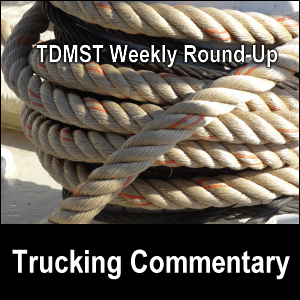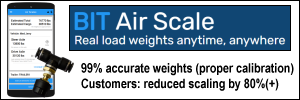This is the TDMST Weekly Round-Up of news affecting professional truck drivers, written by Vicki Simons for the week ending February 23, 2019.
We welcome your comments, thoughts and feedback on the items of your choice below.

1. Regarding unpaid detention time and safety:
According to a February 20, 2019, article:
“The research arm of the Owner-Operator Independent Drivers Association surveyed more than 1,250 truckers about the period of time when a driver is not paid while waiting to be loaded or unloaded.”(a)
The survey found that “many truck drivers believe [that] unpaid detention time… affects safety as well as their finances.”
Truck drivers must never be put in a situation where they consider doing something unsafe just to earn enough money to earn a living.
It is high time that carriers stood up for their drivers in their freight contracts.
And it is high time that shippers and receivers did what was necessary to expedite the movement of freight onto and off of trucks.
As I quoted in the December 2, 2017, issue of TDMST Weekly Round-Up from a 2010 article, “Japan Airlines and ANA topped the rankings of major carriers’ on-time records by FlightStats, a platform by Portland, Ore. company Conductive Technology. … What’s particularly special about Japan Airlines’ 91% on-time record is that it achieved this with more than 215,000 flights during the year.”
If Japan has learned to have such a high on-time record regarding air transportation, isn’t there some way that shippers and receivers can adapt their procedures to lower detention time in the docks for truckers?
2. Regarding truck tolls:
Numerous articles this week have reported that Connecticut’s governor, Ned Lamont — whose campaign included a “trucks-only toll plan” — is now reconsidering that position.
The “legal challenges”, the lack of benefits compared to the costs, and the lack of sufficient revenue “to make a meaningful difference” for his state’s infrastructure were all cited as reasons for his reconsideration in his op-ed column published on February 16.
Articles covering this topic were published here, here, here(b) and here.
Separately, I read that “work continues at statehouses [in 11 states] to come up with their own solutions to help boost transportation funding”.(c)
Furthermore, I read that “the trucking industry is suing to stop the collections [of truck-only tolls] while pushing for an increase in federal fuel taxes to pay for infrastructure construction and repairs.”
3. Regarding driver retention:
A February 19, 2019, article about the “early driver turnover crisis” stated:
“Approximately 60 percent of the more than 3,000 drivers from 89 carriers hired in January 2018 did not make it one year with their carrier.”
This underscores what Todd Spencer of OOIDA has said, that what the trucking industry is facing is not a trucker “shortage” but a trucker “retention” problem.
Recall an October 2018 article in which Spencer said: “what they’re really talking about is that they’re not able to retain people because pay and benefits aren’t adequate. They’re plenty adequate to attract them, but they’re not adequate enough to keep them. So they continually say it’s a shortage.”(d)
4. Regarding trucker document scanning capability:
Do you drive for a trucking company or fleet that provides a monthly incentive for scanning your proof-of-delivery paperwork within 2 hours of delivery?
If so,
- How much is that incentive?
- Is the incentive enough to keep you wanting to earn it?
- How much effort do you have to expend after each delivery?
Please provide a service review of the document scanning service you use.
Separately, I read that “OOIDA offers several apps to help truckers on the road deal with documentation, find help, and determine costs.”(e)
And I ask for your review of these Smartphone apps, too.
5. Regarding autonomous trucks:
According to a February 18, 2019, article:
“Next generation [Freightliner] Cascadia tractors, set for production this Fall, will enable SAE Level 2 automated driving and will become the first production model to hold such distinction in North America. Level 2 automation means the truck can accelerate, decelerate and steer independently.”
The article further quotes DTNA Senior Vice President of Sales and Marketing Richard Howard as saying that the goal of the “safety” innovation is “100 percent accident-free” technology.
Another article about this topic was published here.
While I am firmly convinced that it will be impossible to completely eliminate 100% of accidents — because trucks break down — I admire Howard’s goal.
Perhaps what he really means is to eliminate 100% of all “driver error” caused accidents, but that depends also upon the drivers of other vehicles, doesn’t it?
If you drive one of these semi-autonomous trucks, would you please provide a truck parts review?
6. Regarding black ice, loss of control, and jackknifing:
A news crew video recorded a semi losing control and jackknifing following hitting “a patch of black ice” on I-8 on Friday, February 22.
Separately, black ice was reported to have been “on the roadway at the time of” a “serious pileup” of ten semi trucks on I-80 in Nebraska.
Is it possible to prevent black ice?
If you had the power to prevent (not just treat) black ice, how would you do it?
7. Regarding stopping distance and load securement:
A February 21, 2019, article described that a trucker who was hauling a 43,500-pound steel coil was unable to stop in time for slowed traffic, “swerved into the median to avoid crashing into” the vehicle in front of him, the coil broke free, and it “rolled over the cab of the truck”.
If you haul a flatbed or other trailer with freight that could come loose during transit, please review your company’s load securement procedures to make sure that this kind of situation never happens to you.
8. Regarding potential elimination of speed limits:
According to a February 19, 2019, article, “A California lawmaker has introduced a new bill that would completely eliminate speed limits on two of the busiest roadways in the nation”, namely I-5 and SR 99.
If passed into law, the bill would result in the creation of “a new lane on both directions of the two roadways to be designated as a no speed limit zone”, similar to the situation that exists on Germany’s Autobahn.
Another article about this is here.(f)
Do you think this is a good idea?
Do you think that commercial vehicles will be allowed on such “no speed limit” lanes?
9. Regarding hauling illegal and/or controlled substances:
“A truck driver has been arrested after Border Patrol agents discovered over 900 pounds of suspected methamphetamine hidden in a load of frozen strawberries”, stated a February 21, 2019, article.
The “street value” of the load was estimated to be $12,700,000.
According to a brochure from the National Drug Intelligence Center, a component of the U.S. Department of Justice, “crystal methamphetamine is illegal… [and] is a Schedule II substance under the Controlled Substances Act.”
This news story was also covered here and here.
The risk of being caught hauling illegal and/or controlled substances is too high.
Don’t do it, no matter how much money has been promised to you.
10. Regarding truck fees:
Land Line Magazine reported on February 21, 2019:
“One bill moving through the New Mexico House would increase vehicle fees by an average of 162 percent. Owners of large trucks, however, would pay about 230 percent more.”(g)
Ouch!
If you disagree with this, please voice your opinion regarding HB321.
11. Regarding federal vs. state law trucking regulations:
I disagree with the federal government overruling state governments in any respect.
As I’ve reported before, this includes the FMCSA overriding California’s meal and rest break laws.
And now, even though I don’t like some of their heavy-handed regulations, it extends to that state’s “California Air Resources Board” (CARB).
You may read more about this in a February 22, 2019, article which stated that the Trump administration has ended “emissions negotiations with CARB”.(h)
The article also covered “Corporate Average Fuel Economy (CAFE)”.
12. Regarding the potential increase of trailer size:
A group of large corporations called “Americans for Modern Transportation” is calling on Congress to increase the size of certain trailers to 33 feet, according to a February 19, 2019, article.(i)
The coalition claims that the move will reduce congestion, lower shipping costs, reduce fuel consumption, reduce emissions, provide quicker delivery times, reduce truck crashes, reduce truck miles traveled, and hence reduce the impact to roads and bridges.
Two things that I did not see covered in the article were:
- How will there be a reduction on the impact of moving freight on roads and bridges if more freight is put on fewer vehicles?
- Furthermore, what is the average weight of freight hauled in 28-foot trailers?If a truck’s overall weight is limited to 40,000 pounds without an overweight permit, will lengthening trailers by 5 feet allow that much more freight to be hauled?
13. Regarding “‘right of offset’ language in broker-carrier contracts”:
Owner-operators, read all of the fine print in the contracts before you sign them and beware of what you sign.
Do you understand “right of offset” language and how it could affect your bottom line financially?
According to a February 20, 2019, article:
“There are right now thousands of owner-ops and fleets similarly situated, under contracts [containing ‘right of offset’ language”] that allow, if such a case arises, their businesses to be targeted to please a shipper”.
One specific case was about a broker’s “claim [that he was] entitled to $30K worth of free hauling from a one-truck owner-op”.
Ouch!
14. Regarding blockchain technology:
I read that “The dexFreight platform is built on blockchain technology that allows supply chain stakeholders to transact and collaborate with more efficiency, transparency and security.”
Another recent article stated, “Blockchain can securely track shipments every step of the way”.
How will blockchain technology help or hinder you, trucker?
If you use blockchain technology in the course of your trucking work, would you please provide a service review?
15. Regarding available truck parking vs. paid truck parking
In what happens to be one of the most misguided statements I’ve ever seen published regarding truck parking, the CEO of NATSO (National Association of Truck Stop Operators) stated at its annual convention that “the truck parking issue would be gone if people were willing to pay for it”.
Bahahahaha!
The article cites statistics that bash that CEO’s comment.
My husband Mike and I wish you — and all professional truck drivers — safe travels and lots of money saving opportunities on the road.
Return from TDMST Weekly Round-Up: 2019.02.23 to our TDMST Weekly Round-Up Trucking Commentary or our Truck Drivers Money Saving Tips home page.
Reference:
a. www.landlinemag.com/Story.aspx?StoryID=73788 (no longer online)
b. www.landlinemag.com/Story.aspx?StoryID=73770 (no longer online)
c. www.landlinemag.com/Story.aspx?StoryID=73780 (no longer online)
d. www.landlinemag.com/story.aspx?storyid=73191 (no longer online)
e. www.landlinemag.com/Story.aspx?StoryID=73791 (no longer online)
f. www.landlinemag.com/Story.aspx?StoryID=73801 (no longer online)
g. www.landlinemag.com/Story.aspx?StoryID=73795 (no longer online)
h. www.landlinemag.com/Story.aspx?StoryID=73804 (no longer online)
i. www.landlinemag.com/Story.aspx?StoryID=73779 (no longer online)













